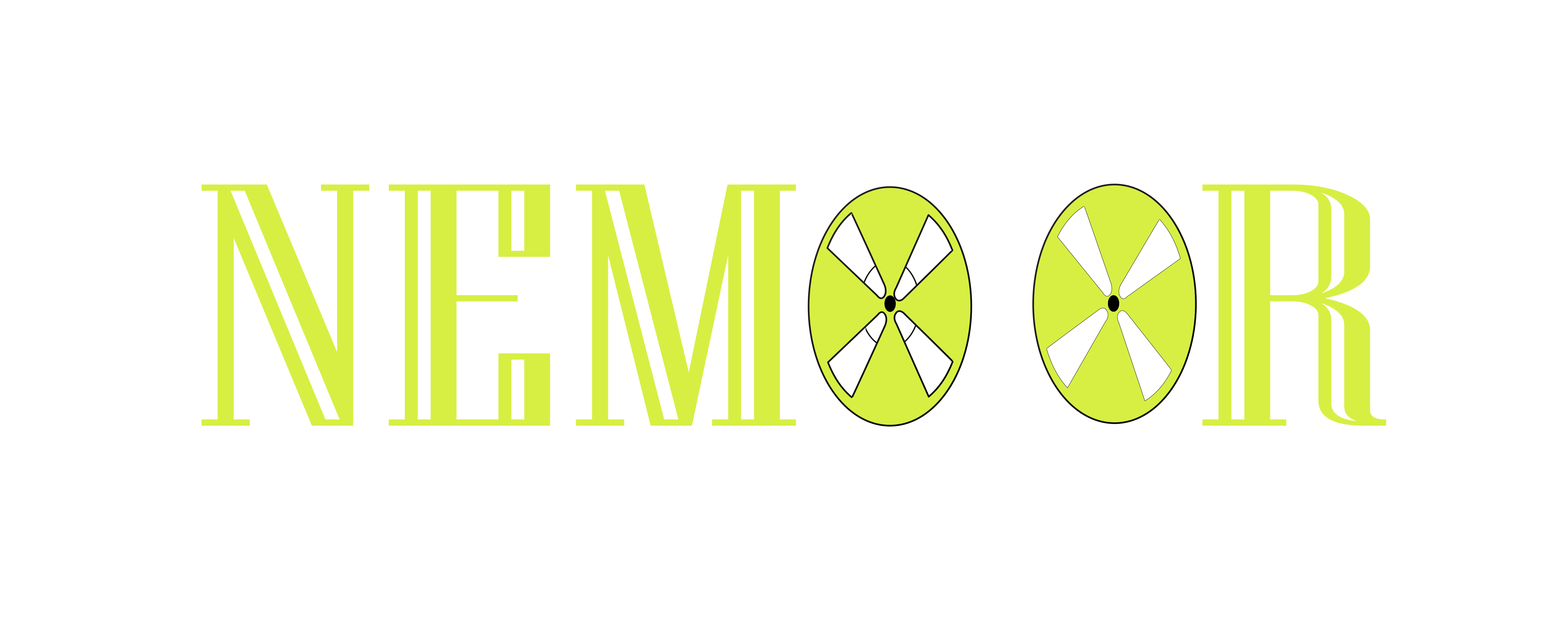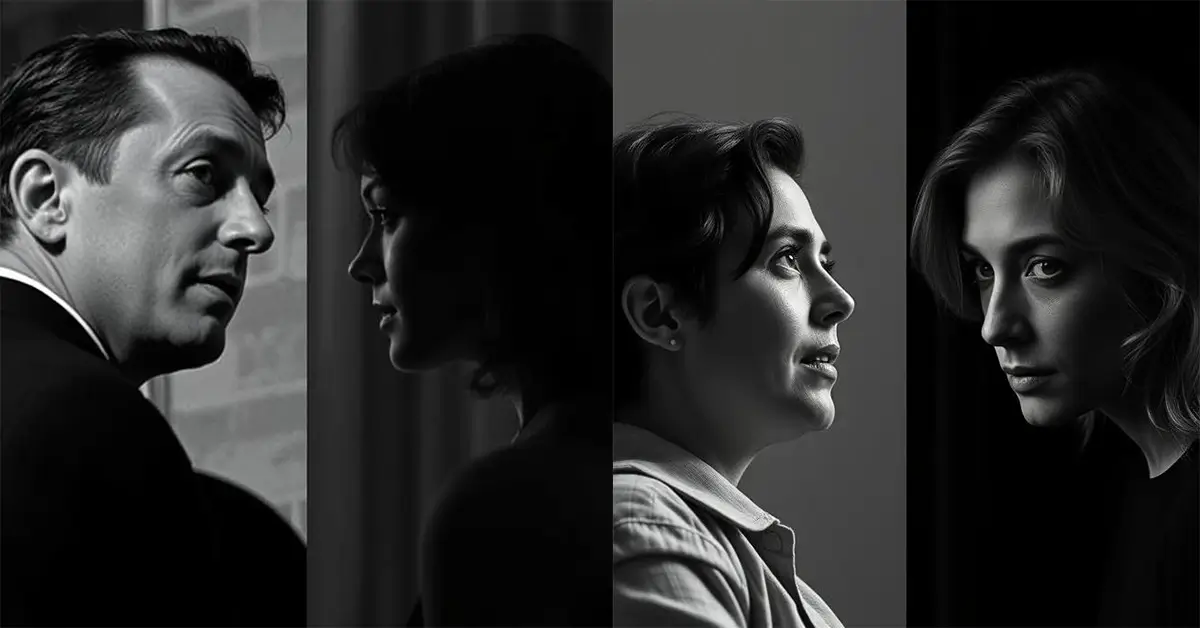Mental Health Representation in Film: A Historical Analysis
Introduction
Mental Health Representation in Film: The flickering images on screen have long served as a mirror to society’s understanding and misunderstanding of mental health. How filmmakers choose to portray characters with mental illness doesn’t just reflect existing attitudes; it actively shapes public perception, influences stigma, and impacts how those living with mental health conditions see themselves represented in culture.
The journey of mental health representation in cinema is one of evolution, albeit slow and often problematic. From the exaggerated portrayals of “lunatics” in early silent films to today’s more nuanced character studies, we’ve witnessed significant shifts in how mental illness appears on screen. These changes parallel broader societal attitudes toward mental health, psychological treatment approaches, and our collective understanding of the human mind.
This historical analysis explores how mental health in films has transformed over the decades, examining the stereotypes that persisted, the breakthroughs that changed the conversation, and the work that still remains to be done. By understanding this evolution, we gain insight into both cinematic history and our cultural relationship with mental health.
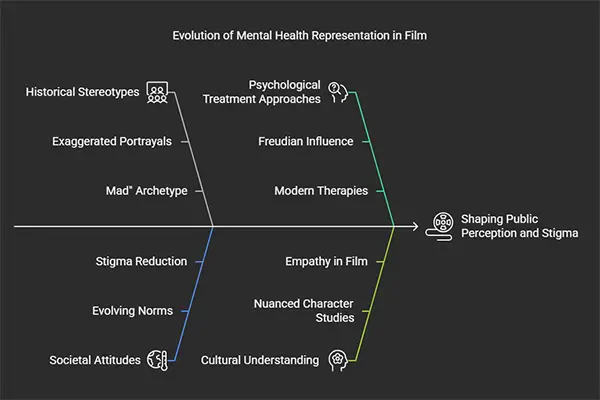
1. Early Depictions (Pre-1950s)
The “Mad” Archetype
In the silent film era and early Hollywood, mental illness was rarely portrayed with nuance or accuracy. Instead, it served primarily as a plot device or character shorthand. The historical portrayal of mental illness in movies from this period relied heavily on visual exaggeration and theatrical performances.
Characters with mental illness typically fell into one of several stereotypical categories:
- The Dangerous Lunatic: Often portrayed with wild eyes, disheveled appearance, and unpredictable violent tendencies
- The Comic Relief: Mental illness played for laughs, with exaggerated behaviors presented as amusing oddities
- The Tragic Figure: Characters whose mental illness was depicted as a devastating tragedy, often with little hope for recovery
Films like “The Cabinet of Dr. Caligari” (1920) used mental illness as a framing device, while “Dr. Jekyll and Mr. Hyde” adaptations presented mental disturbance as a monstrous transformation. These portrayals reinforced the idea that mental illness was something to be feared or pitied, rather than understood.
“Early cinema’s approach to mental illness often revealed more about society’s fears than about the actual experiences of those living with psychological conditions.” – Dr. Andrea Vaughn, Film Historian
Mental health institutions in these early films were typically depicted as gothic, prison-like environments where patients were restrained or subjected to cruel treatments. This reflected the real-world conditions of many asylums of the era but did little to advocate for better understanding or treatment.
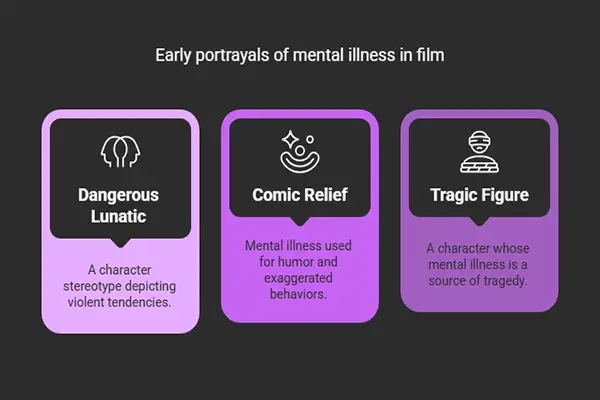
2. Mid-20th Century (1950s-1980s): The Rise of Psychological Thrillers
Freudian Influence and Psychoanalytic Themes
The mid-20th century marked a significant shift in mental health representation, influenced heavily by the mainstream adoption of psychoanalytic theories. The evolution of mental illness in Hollywood during this period closely followed the rise of psychotherapy in American culture.
Filmmakers began exploring the human psyche with greater complexity, though often still through a lens of suspense or fear. Alfred Hitchcock’s “Psycho” (1960) stands as perhaps the most influential psychological thriller of the era, presenting a character with dissociative identity disorder (though using outdated terminology and concepts). While groundbreaking in its psychological depth, it still perpetuated the association between mental illness and violence.
Other notable films from this period include:
| Film | Year | Mental Health Theme |
|---|---|---|
| Vertigo | 1958 | Trauma and obsession |
| Repulsion | 1965 | Paranoia and psychosis |
| One Flew Over the Cuckoo’s Nest | 1975 | Institutional abuse and rebellion |
| Taxi Driver | 1976 | PTSD and alienation |
| The Shining | 1980 | Addiction and psychosis |
“One Flew Over the Cuckoo’s Nest” (1975) deserves special mention for its critical examination of mental health institutions and treatments. While still containing problematic elements, it sparked important conversations about patient rights and institutional reform. The film’s portrayal of electroconvulsive therapy as punishment rather than treatment reflected genuine concerns about psychiatric practices of the time.
During this period, mental health professionals began appearing more frequently as characters, though often portrayed as either coldly clinical or ineffectual. The “talking cure” became a common cinematic device, with therapy sessions serving as exposition for character backstories and motivations.
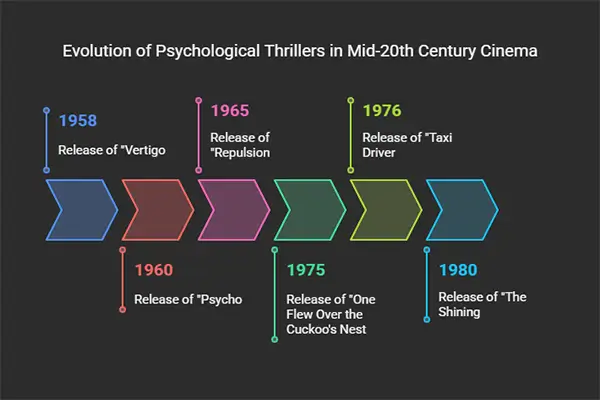
3. Modern Representations (1990s-Present)
Toward Greater Nuance and Empathy
The past three decades have witnessed a significant evolution in how mental health is portrayed on screen. Filmmakers have increasingly sought to present mental health conditions with greater accuracy, empathy, and complexity.
Several factors have contributed to this shift:
- Destigmatization movements: Broader social efforts to reduce mental health stigma
- Psychiatric advances: Improved understanding of mental health conditions and treatments
- Lived experience: More filmmakers and actors drawing from personal experiences with mental health
- Audience demand: Growing viewer interest in authentic, respectful portrayals
Films like “A Beautiful Mind” (2001) attempted to portray schizophrenia from the perspective of the person experiencing it, rather than as an external threat. “Silver Linings Playbook” (2012) presented characters with bipolar disorder and depression navigating relationships and recovery in ways that felt genuine rather than sensationalized.
International and independent cinema has often led the way in sensitive mental health portrayals. Films like “Melancholia” (2011) and “The Skeleton Twins” (2014) explored depression with visual poetry and emotional honesty rarely seen in mainstream productions.
The rise of streaming services has also allowed for more diverse storytelling, with series like “BoJack Horseman” and “This Is Us” developing complex mental health narratives over multiple episodes or seasons.
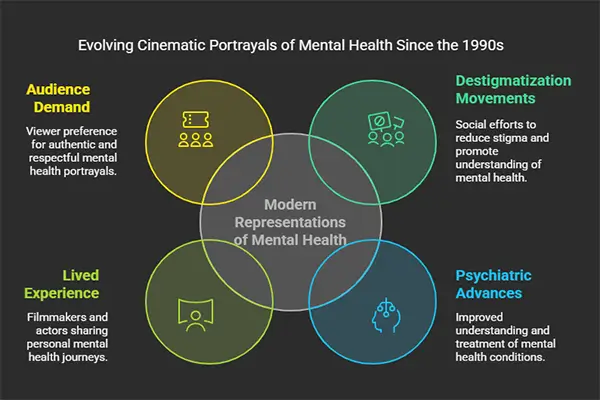
Notable Contemporary Films with Mental Health Themes:
- “Girl, Interrupted” (1999) – Borderline personality disorder
- “The Perks of Being a Wallflower” (2012) – PTSD and depression
- “Inside Out” (2015) – Emotional health and development
- “Short Term 12” (2013) – Trauma and the mental health care system
- “The Farewell” (2019) – Cultural differences in approaching grief and illness
4. What Still Needs Improvement?
Despite significant progress, mental health representation in film continues to face challenges. Many persistent issues need addressing:
Persistent Stereotypes
- The “Dangerous to Others” Trope: Horror and thriller genres continue to disproportionately link mental illness with violence
- Romanticization: Some films inadvertently glorify certain symptoms or present mental illness as a source of creativity without acknowledging suffering
- Recovery Narratives: Many films present unrealistically rapid or complete recoveries, often through love or willpower rather than treatment
Representation Gaps
Certain mental health conditions receive far more screen time than others, with anxiety and depression now relatively common while conditions like schizophrenia remain misunderstood and often misrepresented. Additionally, the mental health experiences of marginalized communities including people of color, LGBTQ+ individuals, and disabled people are frequently overlooked or portrayed through a narrow lens.
Filmmakers’ Responsibility
Filmmakers wield significant influence in shaping public perception of mental health. Responsible representation requires:
- Consulting with mental health professionals during script development
- Including individuals with lived experience in the creative process
- Considering the potential impact of portrayals on viewers, especially those with mental health conditions
- Balancing artistic expression with social responsibility
As filmmaker Ava DuVernay notes: “Storytellers have a responsibility to consider the impact of the images and narratives we create. With mental health, that responsibility is particularly acute because our work can either reduce stigma or reinforce it.”
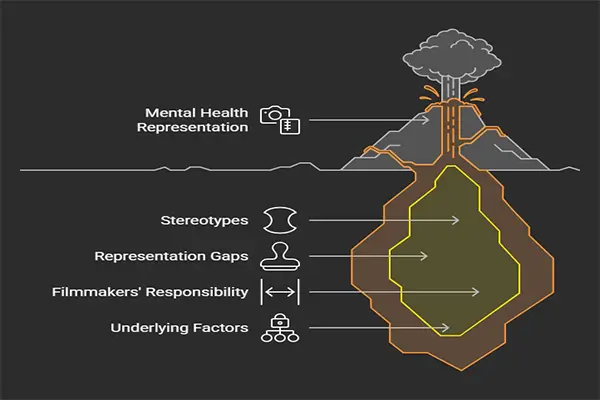
Conclusion
The arc of mental health representation in film reflects our evolving understanding of the human mind and our growing empathy for different experiences. From one-dimensional “madmen” to complex characters whose mental health is just one aspect of their humanity, we’ve come a long way but the journey is far from complete.
For filmmakers, the challenge is to continue developing authentic, nuanced portrayals that neither demonize nor romanticize mental health conditions. For audiences, becoming more critical and informed viewers can help drive demand for better representation.
As we look to the future of mental health in films, several promising trends emerge:
- More filmmakers with personal connections to mental health creating authentic stories
- Increased collaboration between entertainment industry and mental health organizations
- Greater diversity in whose mental health stories are told and who gets to tell them
By continuing to push for thoughtful, responsible representation, we can help ensure that cinema serves not just as entertainment, but as a powerful tool for fostering understanding, empathy, and ultimately, a more compassionate society.
What are your thoughts on how mental health is portrayed in modern films? Have you noticed improvements or persistent issues in recent releases? Share your perspective in the comments below.
For more information on mental health resources or to learn how to support better media representation, visit the National Alliance on Mental Illness (NAMI) or the Entertainment Industries Council.
